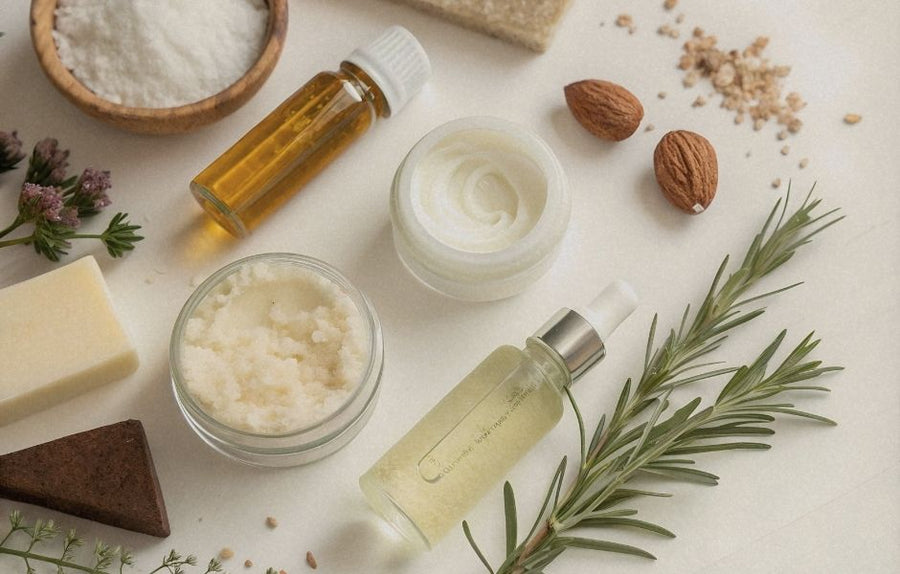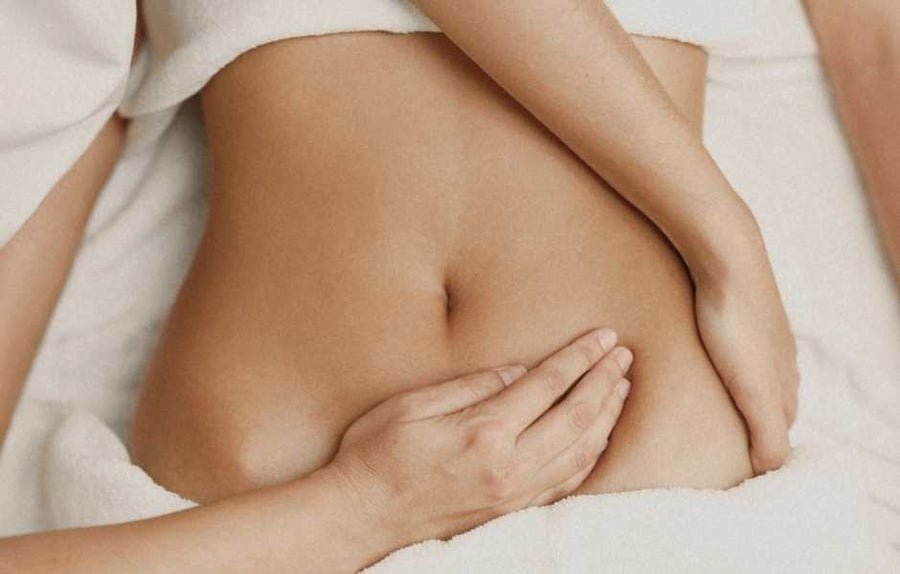
Fragrance Ingredients and Fertility: How Synthetic Fragrances in Personal Care and Household Cleaning Products Affect Reproductive Health
Quick Takeaways
- “Fragrance” on a label is not a single ingredient—it can represent dozens or even hundreds of hidden chemicals (FDA, 2022).
- Phthalates, common in fragrance blends, have been linked to longer time to conceive, altered hormones, and reduced sperm quality (Nobles et al., 2023; Wang et al., 2023).
- Synthetic musks are less studied in humans, but lab research shows they can interact with hormone receptors (Schreurs et al., 2005; Li et al., 2023).
- Fragranced household products release VOCs that add to indoor chemical exposure; fragrance-free versions emit far fewer (Steinemann, 2016; 2020).
- Swapping to fragrance-free products can lower phthalate exposure in just days (Harley et al., 2016).
Introduction
Many people love a good scent—shampoo, laundry detergent, lotions, perfumes. But “fragrance” on a label can be a black box. That single word can represent dozens (even hundreds) of chemicals, some of which are linked in studies to hormone (endocrine) disruption and potential effects on reproductive health. This overview explains what’s in fragrances, what the science says about fertility, and how to lower exposure without losing your routine.
What “fragrance” actually means
When you see “fragrance” or “parfum” on a label, it isn’t one simple ingredient. It’s a mixture of many different chemicals, sometimes dozens, sometimes hundreds. These blends can include aroma compounds (what makes it smell), solvents, and stabilizers that make the scent last longer (FDA, 2022).
One of the most common fragrance chemicals is diethyl phthalate (DEP). The FDA has found DEP in a wide range of personal care items, including fragranced baby products (FDA, 2010). DEP helps scents linger, but research shows phthalates like DEP may act as endocrine disruptors, interfering with normal hormone signaling and potentially affecting reproductive health (Nobles et al., 2023).
Globally, fragrance makers look to the International Fragrance Association (IFRA) for safety guidance. IFRA sets limits or bans on certain fragrance chemicals based on risk assessments, but compliance is voluntary—meaning it’s ultimately up to each brand to decide whether to follow them (IFRA, 2024).
In the United States, the bigger issue is transparency. Companies are legally allowed to list “fragrance” as a single ingredient on product labels, without disclosing the individual chemicals inside (FDA, 2022). Unlike food labels, which must list every ingredient, fragrance formulas are considered “trade secrets” under U.S. law, so consumers are left in the dark about what’s actually in them (California Department of Public Health, 2022).
Why fragrances are discussed in fertility conversations
When people talk about fragrance and fertility, they’re usually thinking about endocrine-disrupting chemicals (EDCs), substances that can mimic, block, or interfere with hormones. Hormones are central to reproductive health, and some fragrance ingredients, especially phthalates and synthetic musks, have shown hormone activity in lab and human studies (Hauser et al., 2016; Gore et al., 2015).
Phthalates (especially DEP)
Phthalates are the most researched fragrance-related chemicals. Studies link preconception exposure to lower fecundability (longer time to get pregnant), changes in reproductive hormones, and oxidative stress (Nobles et al., 2023).
For men, reviews and meta-analyses show that higher phthalate exposure is associated with reduced sperm motility, concentration, and overall quality, direct factors in conception (Wang et al., 2023).
For women, phthalates may disrupt follicle development and ovarian function, both essential for ovulation and egg quality (Panagiotou et al., 2021).
DEP, once considered a “safer” cosmetic phthalate, is still concerning. We can be exposed through skin contact and inhalation. Importantly, biomonitoring studies show exposure drops quickly when people switch to fragrance- or phthalate-free products. The HERMOSA intervention study found significant reductions in just three days (Harley et al., 2016).
Synthetic musks (e.g., galaxolide and tonalide)
Synthetic musks are added to make scents last. While less studied in humans, lab and animal research shows some musks can interact with estrogen, androgen, and progesterone receptors, suggesting possible endocrine activity (Schreurs et al., 2005; Li et al., 2023). Human fertility data are still limited, but the biological plausibility makes them worth noting.
What about everyday fragranced products at home?
Fragrance isn’t just something you put on your skin, it’s in your home. Personal care items, candles, air fresheners, and cleaning sprays all release volatile organic compounds (VOCs) into indoor air, contributing to overall chemical exposure (Steinemann, 2020).
Surveys across multiple countries show that about one in three people report symptoms like headaches, migraines, or breathing issues from fragranced products (Steinemann, 2016). While not everyone reacts, it highlights that fragrance impacts more than just scent.
Why does this matter for fertility? Because some of the same chemicals, like phthalates and musks, are also classified as endocrine disruptors, and studies link them to longer time to conceive, hormone changes, and reduced sperm quality (Nobles et al., 2023; Wang et al., 2023). In short, what you breathe at home may add to the same exposures that scientists are studying in relation to reproductive health.
The good news: fragrance-free products typically emit far fewer VOCs, making them an easy swap during the TTC window (Steinemann, 2020).
Practical, low-effort ways to reduce exposure
You don’t need to overhaul your life. Even small swaps can lower exposure quickly:
-
-
Go fragrance-free (not “unscented”). “Unscented” may still contain masking fragrances. In the HERMOSA study, switching to products labeled free of phthalates, parabens, and phenols for just three days led to measurable drops in these chemicals (Harley et al., 2016).
-
Check labels. If you see “fragrance” or “parfum,” look for brands that disclose full fragrance ingredients or state “phthalate-free.” IFRA sets safety standards, but not all companies follow them (IFRA, 2024).
-
Lean on transparency tools. California’s SB 312 law now requires disclosure of certain fragrance ingredients linked to health or allergy concerns (California Department of Public Health, 2022).
-
Ventilate. Open a window or use a fan while cleaning. Fragrance-free detergents and sprays can significantly reduce indoor VOCs (Steinemann, 2020).
-
Use essential oils mindfully. Essential oils don’t contain phthalates, which makes them a common substitute in clean beauty. But they’re still bioactive, and some oils—such as clary sage and fennel, have shown hormone-like activity in lab studies and are sometimes advised against during the TTC window (Tisserand & Young, 2014; Nielsen, 2012). If you enjoy them, the safer option is to choose products with clearly listed essential oils so you know exactly what’s inside, rather than vague “fragrance” blends.
-
A simple TTC-friendly routine
-
-
Face care: Choose a fragrance-free cleanser and moisturizer to avoid hidden blends. If you want scent, look for brands that disclose full fragrance ingredients and state “no phthalates,” or use products scented with single essential oils (in moderation).
Check out: Timeless Organics Liquid Raw African Black Soap -
Body care: Stick with fragrance-free lotions or oils. For deodorant, choose one that avoids synthetic fragrance and uses either no scent or clearly listed essential oils.
Check out: Mineralized Unscented Deodorant -
Laundry: Switch to a fragrance-free detergent and skip scented softeners. Laundry is one of the biggest daily sources of fragrance exposure.
Check out: MamaSuds Unscented Laundry Detergent -
Home care: Use a fragrance-free all-purpose cleaner, and keep a window open or fan running while cleaning (Steinemann, 2020).
Check out: MamaSuds All-Purpose Cleaner
-
Conclusion
Fragrance isn’t “bad” by itself, but the hidden chemicals behind that label can add to your overall exposure to endocrine-disrupting compounds. For people on a fertility journey, even small swaps like changing detergent or switching to a fragrance-free moisturizer, can reduce exposures quickly (Harley et al., 2016).
The bottom line: awareness gives you choice. By knowing what “fragrance” really means and making thoughtful product decisions, you can support a cleaner, more fertility-friendly environment without giving up everyday comfort.




